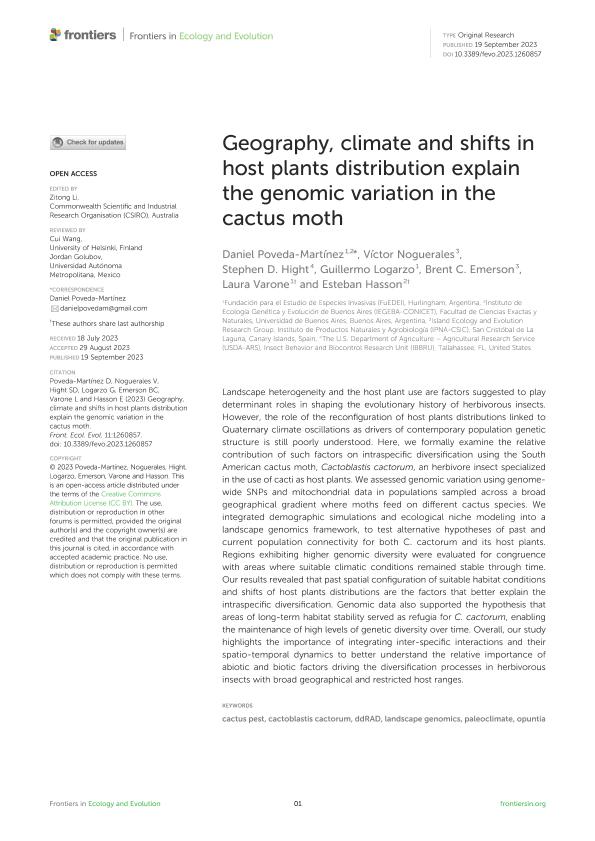Mostrar el registro sencillo del ítem
dc.contributor.author
Poveda Martínez, Daniel Alexander

dc.contributor.author
Noguerales, Víctor
dc.contributor.author
Hight, Stephen D.
dc.contributor.author
Logarzo, Guillermo
dc.contributor.author
Emerson, Brent C.
dc.contributor.author
Varone, Laura

dc.contributor.author
Hasson, Esteban Ruben

dc.date.available
2024-02-26T12:58:59Z
dc.date.issued
2023-09
dc.identifier.citation
Poveda Martínez, Daniel Alexander; Noguerales, Víctor; Hight, Stephen D.; Logarzo, Guillermo; Emerson, Brent C.; et al.; Geography, climate and shifts in host plants distribution explain the genomic variation in the cactus moth; Frontiers Media; Frontiers in Ecology and Evolution; 11; 9-2023; 1-14
dc.identifier.issn
2296-701X
dc.identifier.uri
http://hdl.handle.net/11336/228372
dc.description.abstract
Landscape heterogeneity and the host plant use are factors suggested to play determinant roles in shaping the evolutionary history of herbivorous insects. However, the role of the reconfiguration of host plants distributions linked to Quaternary climate oscillations as drivers of contemporary population genetic structure is still poorly understood. Here, we formally examine the relative contribution of such factors on intraspecific diversification using the South American cactus moth, Cactoblastis cactorum, an herbivore insect specialized in the use of cacti as host plants. We assessed genomic variation using genome-wide SNPs and mitochondrial data in populations sampled across a broad geographical gradient where moths feed on different cactus species. We integrated demographic simulations and ecological niche modeling into a landscape genomics framework, to test alternative hypotheses of past and current population connectivity for both C. cactorum and its host plants. Regions exhibiting higher genomic diversity were evaluated for congruence with areas where suitable climatic conditions remained stable through time. Our results revealed that past spatial configuration of suitable habitat conditions and shifts of host plants distributions are the factors that better explain the intraspecific diversification. Genomic data also supported the hypothesis that areas of long-term habitat stability served as refugia for C. cactorum, enabling the maintenance of high levels of genetic diversity over time. Overall, our study highlights the importance of integrating inter-specific interactions and their spatio-temporal dynamics to better understand the relative importance of abiotic and biotic factors driving the diversification processes in herbivorous insects with broad geographical and restricted host ranges.
dc.format
application/pdf
dc.language.iso
eng
dc.publisher
Frontiers Media

dc.rights
info:eu-repo/semantics/openAccess
dc.rights.uri
https://creativecommons.org/licenses/by-nc-sa/2.5/ar/
dc.subject
CACTOBLASTIS CACTORUM
dc.subject
CACTUS PEST
dc.subject
DDRAD
dc.subject
LANDSCAPE GENOMICS
dc.subject
OPUNTIA
dc.subject
PALEOCLIMATE
dc.subject.classification
Genética y Herencia

dc.subject.classification
Ciencias Biológicas

dc.subject.classification
CIENCIAS NATURALES Y EXACTAS

dc.title
Geography, climate and shifts in host plants distribution explain the genomic variation in the cactus moth
dc.type
info:eu-repo/semantics/article
dc.type
info:ar-repo/semantics/artículo
dc.type
info:eu-repo/semantics/publishedVersion
dc.date.updated
2024-02-22T11:10:15Z
dc.journal.volume
11
dc.journal.pagination
1-14
dc.journal.pais
Suiza

dc.journal.ciudad
Lausanne
dc.description.fil
Fil: Poveda Martínez, Daniel Alexander. Consejo Nacional de Investigaciones Científicas y Técnicas. Oficina de Coordinación Administrativa Ciudad Universitaria. Instituto de Ecología, Genética y Evolución de Buenos Aires. Universidad de Buenos Aires. Facultad de Ciencias Exactas y Naturales. Instituto de Ecología, Genética y Evolución de Buenos Aires; Argentina
dc.description.fil
Fil: Noguerales, Víctor. Consejo Superior de Investigaciones Cientificas. Instituto de Productos Naturales y Agrobiologia.; España
dc.description.fil
Fil: Hight, Stephen D.. United States Department of Agriculture; Estados Unidos
dc.description.fil
Fil: Logarzo, Guillermo. Fundación para el Estudio de Especies Invasivas; Argentina
dc.description.fil
Fil: Emerson, Brent C.. Consejo Superior de Investigaciones Cientificas. Instituto de Productos Naturales y Agrobiologia.; España
dc.description.fil
Fil: Varone, Laura. Fundación para el Estudio de Especies Invasivas; Argentina. Consejo Nacional de Investigaciones Científicas y Técnicas; Argentina
dc.description.fil
Fil: Hasson, Esteban Ruben. Consejo Nacional de Investigaciones Científicas y Técnicas. Oficina de Coordinación Administrativa Ciudad Universitaria. Instituto de Ecología, Genética y Evolución de Buenos Aires. Universidad de Buenos Aires. Facultad de Ciencias Exactas y Naturales. Instituto de Ecología, Genética y Evolución de Buenos Aires; Argentina
dc.journal.title
Frontiers in Ecology and Evolution
dc.relation.alternativeid
info:eu-repo/semantics/altIdentifier/doi/https://doi.org/10.3389/fevo.2023.1260857
Archivos asociados
